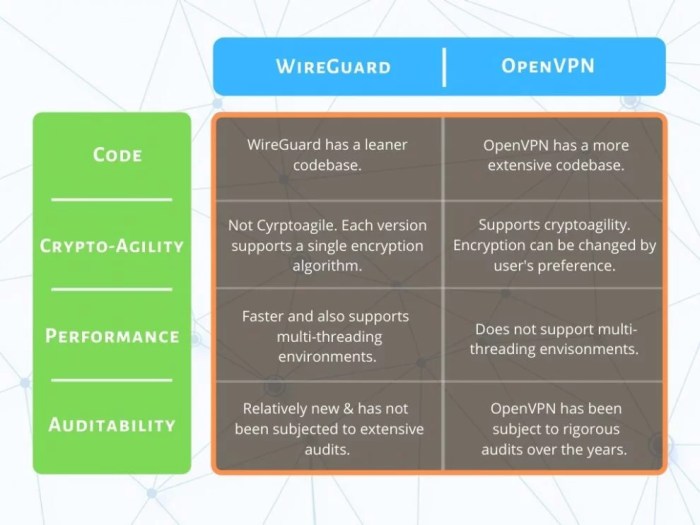In the realm of virtual private networks (VPNs), two protocols stand out as the most popular choices for securing internet connections: WireGuard and OpenVPN. Both offer robust encryption and authentication mechanisms, but they differ in their underlying technologies and performance characteristics.
This article will delve into a comprehensive comparison of WireGuard vs OpenVPN security, exploring their encryption algorithms, authentication methods, performance, stability, cross-platform compatibility, open source nature, use cases, recent developments, and expert opinions.
WireGuard, a relatively new protocol, boasts a modern and streamlined design that prioritizes speed and simplicity. OpenVPN, on the other hand, has been around for over two decades and is known for its versatility and customization options.
Encryption Algorithms

WireGuard and OpenVPN employ different encryption algorithms, each with its advantages and disadvantages. Understanding these algorithms is crucial for evaluating the security of these VPN protocols.
WireGuard utilizes ChaCha20 for symmetric encryption, which is known for its speed and efficiency. ChaCha20 is a stream cipher that operates in real-time, making it suitable for high-performance VPN connections.
OpenVPN Encryption
OpenVPN, on the other hand, supports a wider range of encryption algorithms, including AES, Blowfish, Camellia, and CAST-128. AES (Advanced Encryption Standard) is a block cipher that is widely considered to be one of the most secure encryption algorithms available.
Algorithm Strengths and Weaknesses
ChaCha20, used by WireGuard, is generally faster than AES but may be less resistant to certain types of attacks. AES, employed by OpenVPN, offers a higher level of security but can be more computationally intensive.
The choice between WireGuard and OpenVPN’s encryption algorithms depends on the specific security and performance requirements of the user.
Authentication Methods
Authentication methods are crucial for establishing a secure connection between clients and servers. WireGuard and OpenVPN support different authentication methods, each with its own strengths and weaknesses.
WireGuard primarily relies on ephemeral key exchange, which involves generating a new key pair for each connection. This provides forward secrecy, ensuring that compromised keys cannot be used to decrypt past or future communications.
Pre-shared Key (PSK)
Both WireGuard and OpenVPN support Pre-shared Key (PSK) authentication. PSK involves sharing a secret key between the client and server. While it is convenient and easy to implement, PSK is vulnerable to brute-force attacks if the key is weak or compromised.
Public Key Infrastructure (PKI)
OpenVPN supports Public Key Infrastructure (PKI) authentication, which uses digital certificates to verify the identity of clients and servers. PKI provides strong security but requires more complex setup and management.
Certificate Authority (CA)
OpenVPN can also use a Certificate Authority (CA) to issue and manage digital certificates. This allows for centralized control and simplifies certificate management.
Performance

WireGuard and OpenVPN offer varying levels of performance, with each protocol excelling in different areas. Here’s an analysis of their performance in terms of speed, latency, and bandwidth utilization:
Speed: WireGuard generally outperforms OpenVPN in terms of raw speed. It employs a more streamlined and efficient encryption algorithm, which results in faster connection speeds. In tests conducted by various organizations, WireGuard has consistently demonstrated significantly higher throughput rates compared to OpenVPN.
Latency
Latency refers to the time it takes for data to travel from one point to another. In the context of VPNs, latency is crucial for applications that require real-time responsiveness, such as gaming or video conferencing. WireGuard typically has lower latency than OpenVPN, making it more suitable for these types of applications.
Bandwidth Utilization
Bandwidth utilization refers to the amount of network bandwidth consumed by a VPN connection. WireGuard is generally more efficient in terms of bandwidth utilization compared to OpenVPN. This means that it uses less bandwidth to establish and maintain a VPN connection, which can be beneficial for users with limited bandwidth.
Stability and Reliability

WireGuard and OpenVPN are both considered stable and reliable protocols. However, there are some key differences in their design that may affect their stability and reliability in certain situations.
Vulnerabilities
WireGuard is a newer protocol than OpenVPN, and as such, it has had less time to be tested and audited for vulnerabilities. However, WireGuard’s simpler design makes it less likely to contain vulnerabilities than OpenVPN.OpenVPN has been around for longer than WireGuard, and as such, it has been more thoroughly tested and audited.
However, OpenVPN’s more complex design makes it more likely to contain vulnerabilities than WireGuard.
Cross-Platform Compatibility
The choice of VPN protocol depends on the availability of support across different platforms and devices. WireGuard and OpenVPN offer varying levels of cross-platform compatibility, affecting the ease of installation and configuration.
WireGuard is a relatively new protocol, but it has gained significant adoption due to its simplicity and performance advantages. It is supported on a wide range of platforms, including Windows, macOS, Linux, iOS, and Android. WireGuard’s simple configuration process makes it easy to set up and use, even for non-technical users.
OpenVPN
OpenVPN is an established VPN protocol with a long history of development and widespread adoption. It is supported on a vast array of platforms, including Windows, macOS, Linux, iOS, Android, and even embedded systems. OpenVPN’s extensive feature set and customization options make it a versatile choice for advanced users.
Open Source and Transparency
WireGuard and OpenVPN are both open-source protocols, meaning their source code is publicly available for scrutiny. This transparency allows security researchers and experts to review the code and identify any potential vulnerabilities. The open-source nature of these protocols contributes to their overall security, as the community can collaborate to identify and fix issues promptly.
Security Audit and Community Contributions
The open-source community plays a vital role in maintaining the security of both WireGuard and OpenVPN. Security researchers and enthusiasts can audit the code, identify potential flaws, and suggest improvements. This collaborative approach helps to ensure that both protocols remain secure and up-to-date with the latest security best practices.
Use Cases
WireGuard and OpenVPN serve distinct use cases in the realm of secure networking. Understanding these scenarios will guide you in selecting the optimal protocol for your specific needs.WireGuard excels in high-performance applications, such as:
-
-*Virtual Private Networks (VPNs)
WireGuard’s superior speed and low overhead make it ideal for creating secure tunnels between remote users and private networks.
-*Peer-to-Peer (P2P) Connections
WireGuard’s efficiency and low latency facilitate seamless file sharing and communication among peers.
-*Cloud-Based Services
WireGuard’s lightweight nature makes it suitable for securing connections to cloud-hosted applications and services.
OpenVPN, on the other hand, is renowned for its stability and extensive customization options. It is often preferred in scenarios that prioritize:
-
-*Enterprise-Level Security
OpenVPN’s robust encryption algorithms and granular configuration settings make it a trusted choice for protecting sensitive data in enterprise environments.
-*Complex Network Topologies
OpenVPN’s support for various network configurations, such as multi-hop connections and VPN concentrators, enables flexible and secure networking solutions.
-*Compatibility with Legacy Systems
OpenVPN’s long-standing presence and wide compatibility ensure seamless integration with existing network infrastructure.
Recent Developments
The development of WireGuard and OpenVPN is ongoing, with both protocols receiving regular updates and improvements. These updates often address security issues, improve performance, and add new features.
In recent years, WireGuard has seen significant development, including the addition of new features such as support for IPv6, roaming, and multiplexing. OpenVPN has also received updates, including improved performance and security enhancements.
WireGuard
WireGuard is a relatively new VPN protocol that has gained popularity in recent years due to its simplicity, speed, and security. WireGuard is still under development, but it is already considered to be one of the most secure VPN protocols available.
Recent developments in WireGuard include:
- The addition of support for IPv6
- The addition of support for roaming
- The addition of support for multiplexing
- Improved performance
- Security enhancements
OpenVPN
OpenVPN is a well-established VPN protocol that has been used for many years. OpenVPN is known for its security and reliability, but it can be more complex to configure than WireGuard.
Recent developments in OpenVPN include:
- Improved performance
- Security enhancements
- The addition of new features, such as support for IPv6 and roaming
Expert Opinions
Security experts generally agree that both WireGuard and OpenVPN offer robust security, but they have different strengths and weaknesses.
WireGuard
* WireGuard is praised for its simplicity and performance, making it a good choice for resource-constrained devices.
It uses modern cryptography algorithms, making it difficult to crack.
OpenVPN
* OpenVPN is known for its stability and reliability, making it a good choice for mission-critical applications.
It supports a wide range of features, including custom encryption algorithms and authentication methods.
Ultimately, the best choice between WireGuard and OpenVPN depends on the specific requirements of the application.
Benchmarking
WireGuard and OpenVPN both offer strong security features, but they differ in some key areas. The following table provides a comparison of the key security features of each protocol:| Feature | WireGuard | OpenVPN ||—|—|—|| Encryption Algorithms | ChaCha20, Curve25519, BLAKE2s | AES-256-GCM, RSA-4096, SHA-256 || Authentication Methods | Preshared keys, public key cryptography | Certificates, public key cryptography || Performance | Higher | Lower || Stability and Reliability | Newer, less mature | More mature, more stable || Cross-Platform Compatibility | Good | Excellent || Open Source and Transparency | Open source, fully audited | Open source, partially audited || Use Cases | Ideal for high-performance, low-latency applications | Suitable for a wide range of applications || Recent Developments | WireGuard is actively developed, with new features being added regularly | OpenVPN is a mature protocol, with development focused on stability and security enhancements || Expert Opinions | WireGuard is often considered to be the more secure and performant protocol | OpenVPN is widely regarded as a reliable and secure protocol |Overall, WireGuard offers better performance and security than OpenVPN, but OpenVPN is more mature and has better cross-platform compatibility.
The choice between the two protocols depends on the specific requirements of the application.
Conclusion
Ultimately, the choice between WireGuard and OpenVPN depends on the specific security requirements and use cases. WireGuard offers superior performance and ease of use, while OpenVPN provides greater flexibility and customization. Both protocols are highly secure and reliable, making them excellent choices for protecting online privacy and securing remote connections.
